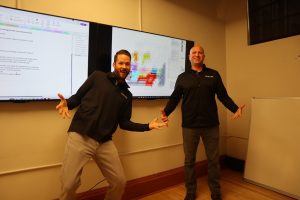This week we honor our healthcare partners as we celebrate alongside them with national hospital association week. It’s a privilege to collaborate and work with the leading healthcare systems in southern Wisconsin, and we commend their unwavering dedication to promoting health and wellness in our communities. Much like healthcare industry, JP Cullen also has specialized professionals who are experts in their respective markets, our construction team operates with the same level of expertise specific to sensitive, healthcare construction. We have over 15 million sqft of healthcare construction under our tool belt and counting!
Healthcare construction is the front line of active patient care, requiring specialized attention and planning when it comes to building within these innovative environments. We have a team of tenured and respected skilled trades staff, superintendents, and project managers who exclusively work within the healthcare market. We sat down with one of those Superintendents to learn more about his vast experience within hospitals, clinics, and healthcare environments.
Randy Kisley has been with JP Cullen for just under twenty years, and in the Healthcare construction industry for a total of 25 years. Over his career he has spent over 52,000 hours working in Wisconsin Healthcare Facilities. Being an expert in the field of sensitive construction, he is the perfect candidate to give us a glimpse and his insights into the skilled trades work that takes place in hospital, clinics and heeling environments.
- What makes a construction project within an active hospital different?
R: Construction within an active hospital is a complex and delicate process that requires careful planning, and coordination to minimize (if any) disruptions to patient care and ensure the safety of patients, staff, and construction workers. Also taking into consideration the additional safety measures like infectious control, noise pollution, access points, and coordination effort within an active hospital need to be carried out safely and efficiently.
- Have you encountered a specific challenge in your career, you overcame within an active healthcare facility?
R: During 2020, we had to pivot an entire construction project and schedule to a complete shut down in order to focus in on a new project, Covid hot and cold spots within one of the largest hospitals in the state. We stopped building and worked as an extension of the hospital to build temporary walls in every department, waiting rooms, hallways, you name it. At the same time, we were assisting in creating more capacity for patients, at a time of heightened worry when the outlook on the pandemic was unsure, we were accelerating another project schedule to renovate the Emergency Department, in order to get the additional space needed to treat the patients during the pandemic. We never stopped construction and worked off shift hours to accommodate staff and patients for months on end. This was a challenge not only due to construction but juggling the fear at the beginning of the pandemic and being in the hot zone daily in order to make sure we were doing our part to help patients, and the staff at the front lines.
- How do you ensure that construction meets quality standards and healthcare specific requirements?
R: The quality assurance processes are in place throughout construction to ensure that the new spaces meet all of the required standards. This includes regular inspections, testing, and monitoring of construction activities. Before handing over the project to the client, I always conduct final inspections and commissioning to ensure that all systems and components are functioning correctly and meet quality standards. This includes medical equipment that we bring in end-users to make sure it’s perfect before any patient comes close to being treated. Right before we turn a project over to the end users, I always provide owner trainings on building systems, equipment and safety procedures, and a tip that I like to encourage the owners to participate in, recording these trainings so they have something to reference back to, and review these for new employees or any trainings that might come up down the line.
- How do you prioritize the comfort and safety of patients and staff during construction?
R: We keep the patients front of mind on all projects, first and foremost. In addition to that thinking, using methods like temporary barriers, sound-absorbing materials, scheduling noisy work during off hours when less patients are onsite and providing additional support to patients who may be affected by the construction activities. These activities can generate a lot of noise and vibration which can be disruptive to patients and staff. We take this into consideration at the front end of a project, during planning of our schedules to minimize the noise and allow us to notify the owner weeks in advance of when the activity would take place.
- How do you handle the transition from construction to end-users to ensure a smooth handoff of a space?
R: I’ve found this process works best if it starts on day one using key construction concepts like the Lean Construction method of “Big Rooms”. This concept is based on the idea of collaborating with all key project stakeholders in one space to enhance communication, discussion and decision making throughout the project lifecycle. Before a project even starts, we are thinking about user needs assessments, design integration, quality assurance, user experience and post construction support to ensure all of our clients are happy in their new space. By focusing on the needs and experiences of the end-users and patients throughout the construction process, we can deliver projects that not only meet the required technical standards but also help to provide better more efficient patient care and provide value to those who will work within the space.

Randy is currently working in southern Wisconsin on an addition and renovation to a hospital’s emergency department. If you would like to learn more about our extensive healthcare experience, please visit Healthcare | JP Cullen











